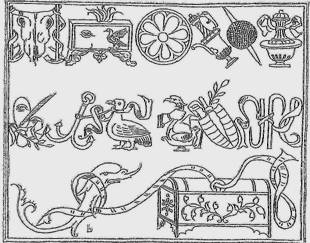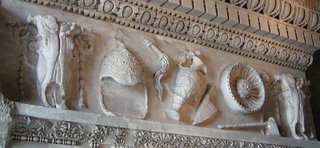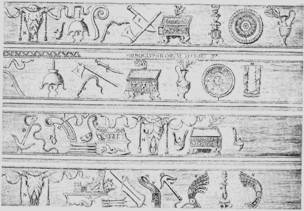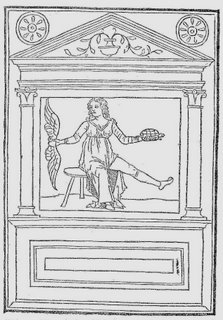Peplos Part II
One theory as to the origin of the Peplos of Aristotle revolves around its connection with the Pananthenaic peplos. This idea is directly alluded to in the introduction to the 1798 edition of the Peplos with which I started the first entry of the Peplos blog. Here the commentator says that 'the peplos was the sail on the Panathenaic ship on which was depicted the killing of Enceladus by Minerva (Athena) and those strong men who were worthy in war for the fatherland.' For his authority, he quotes a passage from the Knights of Aristophanes which essentially repeats the phrase I have given above. This interpretation of the passage is repeated as authoritative by later commentators including, for instance, Th. Preger in his article Zum Aristotelisches Peplos in the Abhandlungen aus dem Gebiet, Munich 1891, although it will be noted that Aristophanes says nothing about Troy, about epitaphs or about Aristotle.
The Pananthenaic peplos was the cloth or dress which was carried in procession at the festival and offered to the statue of the goddess, Athena, within the Parthenon. It is possible that there were two peploi, one a small one used in the annual festival and the second one a large one which was used in the four yearly great festival and was large enough to serve as the sail of a ship, which was wheeled through the streets, before being presented to Athena. For those who are interested in further details, I recommend Mansfield's dissertation on the subject, The Robe of Athena and the Pananthenaic Peplos (UCL, Berkeley,1985). It is clear from this that the ceremony did not originate in Athens and was not confined to that city; Mansfield identifies 34 other locations where there were ceremonies presenting garments to statues of gods and 15 where there is some evidence of the practise. Even in the Iliad, when things are looking bleak for the Trojans, the women present their statue of Athena with a new peplos, so it was clearly an ancient custom.
Theories as to the purpose of this ceremony and the origin of the peplos as a sacred object will be given in another edition of this peplos thread. For instance, it is supposed that the tradition of the sail hanging on the mast of the wheeled ship was derived from the ancient ceremony of covering a sacred tree with a cloth. But more of that another time.
When and what was the origin of the Panathenaic procession. According to Apollodorus (Library 3.14.6) the Pananthenaia was started by Ericthonios the founder of Athens or, according to Pausanias, by Cecrops, Ericthonios' son. This would have been about 1550 BCE. When was the ceremony of the peplos introduced: possibly during the late 6th century during which Athens defeated Boeotia where the rite of the peplos may have originated and certainly no later than the middle of the 5th century BCE when the Parthenon was built since the procession of the peplos is depicted on the frieze of the Parthenon. Some say that the ceremony of the peplos began after the victories of the Persian war and if this were the case it would make sense if heroes were depicted on the peplos although they would not have been Trojan heroes.
Plato says (Euthyphro) that the peplos showed the gigantomachy or struggles of the gods and Aristophanes in the Birds says it shows the gods 'withering the sons of the Earth.' The meaning of the Knights passage of Aristophanes referred to above is actually ambiguous. Mansfield and later commentators say that it refers 'Athena's deeds of prowess' and not to great men or heroes. There is a third possible interpretation: something like, 'the peplos is worthy of Attica and the Knight's place in its great religious festival'. Again nothing to do with the heroes of Troy.
Another relevant reference is in Aristotle's Athenian Constitution (49.3) which says 'At one time the Council used also to judge the patterns for the Robe, but now this Council was thought to show favoritism in its decision.' (trans. H. Rackham). This extracts implies several things: that the pattern was different each year, that there was a competition for the winning design of any one year and that this competition was eventually abandoned and thus presumably the design became fixed. The competition could however have been for only a part of the Peplos, perhaps a decorative border, but not the main subject matter showing Athena and her defeat of the giants.
There is no evidence here for or against the possibility that, in one year or several, the Peplos could have depicted as its main or subsidiary subject the heroes of the Trojan war.
There is another reference to the Pananthenaic Peplos in Plutarch's essay Life of Demetrius, the possibly fictional character who conquered Athens and is said to have required that his image be woven on the peplos besides that of Athena and Jupiter. This demand so enraged the gods that during the procession the peplos was said to have torn in two in the wind. But again there is no mention here of heroes or giants. Demetrius lived in theory about 300 BCE.
It appears that we have to accept that there is no evidence for a direct link between the Pananthenaic peplos and the Peplos of Aristotle. We shall have to look elsewhere.

 The frieze from the Temple of Vespasian
The frieze from the Temple of Vespasian The Capitoline Frieze
The Capitoline Frieze A fresco from San Giustina
A fresco from San Giustina From the Poliphili
From the Poliphili Fantastic letters from the Champ Fleury
Fantastic letters from the Champ Fleury